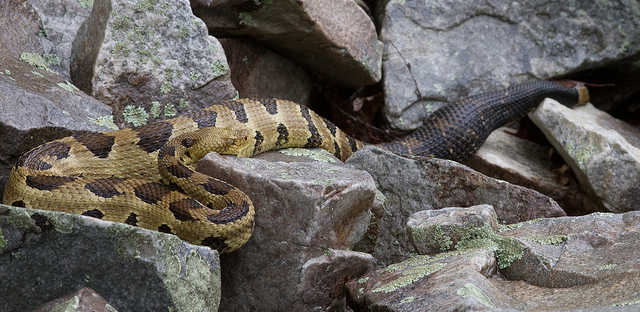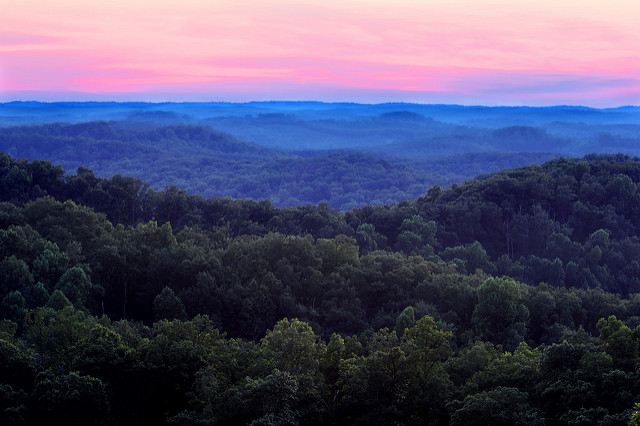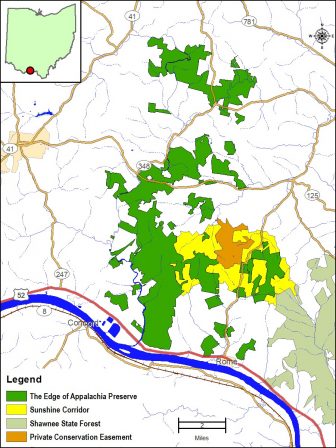
A timber rattlesnake at its den in Virginia. Image: Brian Gratwicke, Flickr.
By Megan McDonnell
The most dangerous snake in northeastern America is in rapid decline due to habitat loss and the threat of human development.
But the expansion of Ohio’s largest privately-owned protected forest, known as the Edge, could protect the timber rattlesnake and other rare wildlife from development, the timber industry and invasive species.
Southern Ohio’s the Edge of Appalachia Preserve is one of the few places the timber rattlesnake lives. The sanctuary is expanding through a partnership between a land conservation group and the Ohio Department of Natural Resources (ODNR).
Owned and maintained by the Nature Conservancy, a global conservation organization, the 19,000-acre mixed hardwood forest preserves and restores habitat, according to the group’s website.
“The Edge of Appalachia is home to some of Ohio’s more wilderness species, including the timber rattlesnake,” said Nature Conservancy Appalachian Forests project manager Martin McAllister.
The Edge is home to several hickory species, McAllister said. The trees are of ecological importance for various species of plants and animals, including the timber rattlers — a snake that can grow to 6 feet in length.
According to the Ohio Ornithological Society, a statewide birding organization, the Edge houses more than 107 bird species, 11 of which are of high conservation concern, and is vital to migration and breeding patterns.
Despite being the largest privately owned protected forest in Ohio, the Edge is threatened.
One area in particular, dubbed the Sunshine Corridor, has felt the negative effects from unsustainable forestry practices, McAllister said.
“People leave the lower-grade woods,” he said. “We can go in and issue contracts to remove the lower-grade species of trees, which improves the overall health of the forest.”
The Sunshine Corridor is a 3,000-acre forest connected to the Edge. It will double in a Conservancy Forestry Legacy project.

Shawnee State Forest in southwest Ohio. Image: Christa Binder, Flickr.
About six years ago, an idea was presented to launch a massive conservation effort to connect the 19,000-acre Edge to the Shawnee State Forest, making it the largest contiguous piece of protected land in the history of Ohio.
Greg Guess, the deputy chief of the ODNR Division of Forestry, said that the 64,000-acre Shawnee State Forest is also the state’s oldest forest.
It contributes to the local economy and habitat diversity by allowing 2 million to 4 million trees to be harvested annually, Guess said.
The harvesting, milling and manufacture of wood products employs more than 118,000 people and contributes $22 billion to the state’s economy, said Stephanie Leis, public information officer at ODNR office of communications.
However, not all of the state forest is open to timbering.
A 1,168-acre area of the 64,000-arcre Shawnee State Forest is a designated wilderness called Shawnee State Park to “maintain its natural beauty,” according to the ODNR.

Image: The Nature Conservancy
To connect the two areas, the Conservancy needs to purchase 140 parcels, totaling to 6,000 acres of privately owned property for $10 to $12 million.
“We’re halfway to our goal,” McAllister said.
Shawnee State Forest recently acquired a 929-acre addition, ODNR said. The Nature Conservancy doesn’t own the new addition and it is not part of the Sunshine Corridor project.
“It’s really satisfying to see the pieces of the puzzle coming together at the Shawnee State Forest as we work to connect it with our Edge of Appalachia Preserve,” Bill Stanley, the assistant Ohio director of the Nature Conservancy, said in a press release.
The two properties are nearly connected and so close together that it’s nearly possible to walk from the Edge of Appalachia to the Shawnee State Forest without touching private property.
The Conservancy plans to buy the remaining parcels within the next five to six years.